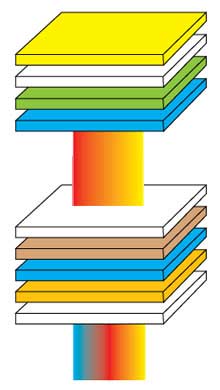A new process for printing plastic solar cells boosts the power generated by the flexible and cheap form of photovoltaics. Initial solar cells made with the technique can, according to a report in today's issue of Science, capture solar energy with an efficiency of 6.5 percent--a new power record for photovoltaics that employ conductive plastics to generate electricity from sunlight. Most photovoltaics are made from conventional inorganic semiconductors.
conventional inorganic semiconductors.
The new process stacks multiple polymer layers within a single photovoltaic device to produce a "tandem" cell. Alan Heeger, who won the 2000 Nobel Prize for his codiscovery of electrically conducting polymers, and his colleagues at the University of California, Santa Barbara (UCSB), created the process with a group from South Korea's Gwangju Institute of Science and Technology. Heeger says that the tandem architecture offers plenty of room for further improvement--enough to eventually make plastic solar cells practical in rooftop solar panels. "We see a pathway here toward even higher efficiencies," he says. "We can do significantly better than 6.5 percent in the near future."
Tandem cells, commonly employed in conventional solar panels, increase power output in two ways. The semiconductors in the different layers can be optimized to capture different bands of light, thus enabling the tandem device to absorb a broader spectrum of sunlight. And the multiple layers boost the voltage of the tandem device, yielding more power from every photon absorbed. "You do a better job of light harvesting and a better job of utilizing the photon energy," explains Heeger.
Until now, however, the tandem architecture spoiled plastic photovoltaics such as Heeger's, which are "printed" by spraying solutions of conductive plastics and other materials onto a plastic film. Layers of different plastics sprayed on top tended to mix, degrading rather than enhancing power output. Heeger and his colleagues beat the mixing problem by finding an effective spray-on separator to keep the layers in place.
The bottom cell is filled with a proprietary polymer first disclosed last year by plastic PV developer Konarka Technologies, based in Lowell, MA, which Heeger cofounded and for which he serves as chief scientist. The polymer (a derivative of polythiophene) absorbs both infrared and ultraviolet light. Next comes a titanium-suboxide layer, which seals in the bottom cell, provides a foundation for building the top layer, and, as it's a metal, efficiently carries away the charged electrons generated in both layers. Finally, the top layer sports a different type of conducting polymer that absorbs mostly blue and green light.
Heeger expects further efficiency strides as device developers gain experience with the cell's new materials. For example, in May, the UCSB researchers reported a processing tweak that doubles the power output of single cells made with Konarka's new polythiophene polymer. Heeger says that the processing trick was not used in the tandem cell. Read

